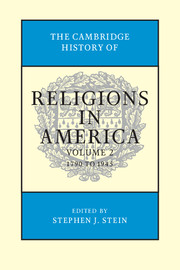Book contents
- Frontmatter
- Contents
- Contributors
- Editor's Introduction
- SECTION I RELIGION IN NORTH AMERICA
- SECTION II RELIGIONS IN THE NEW NATION, 1790–1865
- SECTION III CHANGING RELIGIOUS REALITIES
- SECTION IV RELIGIOUS RESPONSES TO MODERN LIFE AND THOUGHT
- SECTION V COMPARATIVE ESSAYS
- SECTION VI RELIGION AND DIVERSE AREAS
- Index
Editor's Introduction
Published online by Cambridge University Press: 28 July 2012
- Frontmatter
- Contents
- Contributors
- Editor's Introduction
- SECTION I RELIGION IN NORTH AMERICA
- SECTION II RELIGIONS IN THE NEW NATION, 1790–1865
- SECTION III CHANGING RELIGIOUS REALITIES
- SECTION IV RELIGIOUS RESPONSES TO MODERN LIFE AND THOUGHT
- SECTION V COMPARATIVE ESSAYS
- SECTION VI RELIGION AND DIVERSE AREAS
- Index
Summary
A new chapter in the history of American religions was inaugurated with the formation of the United States following the War for Independence. The century and a half after 1790 witnessed astonishing changes in the circumstances of the North American continent and in the religious traditions and institutions located on it. The United States evolved into a world power, and the religious institutions that were part of American society and culture came to occupy signifi cant positions of cultural influence. Confl ict and controversy were also part of the record as the religious traditions interacted variously with one another and with the social and political developments in the nation and the world. This Introduction to the second volume of The Cambridge History of Religions in America looks briefl y at some of the judgments rendered by the authors of the essays that follow dealing with this period of American religious history.
In 1787 after the end of the Revolutionary War, representatives from the thirteen English colonies gathered for a convention in Philadelphia, a meeting that extended from late May until mid-September, in which they drafted the U.S. Constitution. The Preamble of that document affirms a set of high social ideals. “We the people of the United States, in order to form a more perfect Union, establish justice, insure domestic tranquility, provide for the common defense, promote the general welfare, and secure the blessings of liberty to ourselves and our posterity, do ordain and establish this Constitution of the United States of America.” More than one year had passed after that convention before a suffi cient number of colonies ratifi ed the Constitution; then on 4 February 1789, presidential electors named George Washington the fi rst president of the United States . Two states, however, did not approve the Constitution until additional rights were guaranteed, including one that addressed religion, a process that took until December of 1791 to complete. The First Amendment to the Constitution in the Bill of Rights addressed directly the issue of religion in the new nation.
- Type
- Chapter
- Information
- The Cambridge History of Religions in America , pp. xiii - xxivPublisher: Cambridge University PressPrint publication year: 2000



